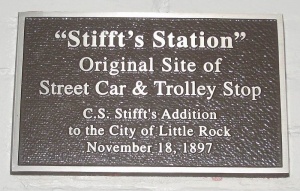Stifft's Station
Stifft's Station is a former streetcar stop for The Heights neighborhood of Little Rock located at the corner of Markham and Kavanaugh (formerly Prospect) streets. The station served the Pulaski Heights Line, which operated from 1904 to 1947.
The station is named after jeweler Charles S. Stifft, whose proposed Stifft Addition to the city was platted on November 19, 1898. Other named investors in the addition were Charles' wife Rebecca Stifft, Robert E. Wait and second wife Isabella Wait, and Maxwell Coffman and wife Annie Coffman. Later investors would include Sidney Stifft and Perry Stifft.
The buildings and areas immediately surrounding the streetcar stop are now known collectively as the Stifft Station Historic District. The boundaries of the district are formed by Markham to the north, Woodrow to the east, Seventh Street to the south, and Martin to the west. Other city additions located within the district boundaries are the C. O. Kimball and Bodemann Addition (1890), Beach Addition (1893), Feild's Addition (1911), Hick's Subdivision of Block 4 of Boone's Addition (1912), and the E. F. Feild Addition (1926). Woodruff Elementary School is located at the southeastern corner of the historic district. The Billy Mitchell Boys and Girls Club at 3107 West Capitol Avenue is inside the boundaries of the district, as is Lamar Porter Field at 2700 West Seventh Street.
Nearly all structures in the district were constructed after 1905. The first two homes documented in the district date to around 1914: 522 Martin, owned by Benjamin Robinson, and 600 Martin, owned by Lena Conway. The area is mainly residential, with about a third of the cottage and bungalow homes dating to the 1920s. Most houses are in the Craftsman, Tudor, or Colonial Revival style, and reflect the income levels of moderate, working class families. Some larger homes for middle class residents are found on the 100 block of Johnson Street.
In the mid-1990s the eastern half of the district contained 653 residents, about 26 percent of whom were African American. The western half of the district had 897 residents, about 53 percent of whom were African American. About half the homes in the area were rentals.
The commercial corridor on the northern edge of the district is the past and present location of a number of businesses. This corridor is now dominated by a large mural painted in 1996 by Roland Burnham, who used to paint alien heads as the tagger "Balstovitch." The neighborhood is also famous for producing a number of talented local musical acts and what has come to be called the Stifft Station Sound.
Contents
Businesses in the Stifft's Station Historic District
- Best Car Wash - owned by Willis Smith & Norm Blasingame
- Buice Drug Store (3013 West Markham Street) - owned by Bob Buice, George E. Wimberly
- George Jett's Gas & Service Station, formerly BP, and before that Lion Oil's last company station (3101 West Markham Street)
- Jerry Meyers Agency (3001 West Markham Street)
- Marnye's Hair Salon (2901 West Markham Street)
- Orbea Bicycles (1009 Kavanaugh Boulevard)
- Pizza D' Action (2919 West Markham Street)
- The Oyster Bar (3003 West Markham Street) - owned by Virginia Boyd
- Sandalwood Forest (2915 West Markham Street, 3015 West Markham Street) - owned by Kirsten Khanton
- The Spirit Totem, formerly "The Broom Closet" (3009 West Markham Street) - owned by Karin Hall-Willis
- The Station Community Grocery and Deli (1001 Kavanaugh Boulevard) - owned by Holly Ingebo & Casey Pierce
- Unity Martial Arts (3016 West Markham Street) - owned by Sensei Tanner Critz
- Whitewater Tavern (2500 West Seventh Street)
Notable closed businesses
- Alternatives Silkscreen & Dyeworks - owned by Doug Norton
- American Medical Rentals (3015 West Markham Street)
- Anthro-Pop Records (2915 West Markham Street) - owned by Rod Bryan
- Arkansas Hospice Resale Shop (1009 Kavanaugh Boulevard)
- Atomic Guitars (3015 West Markham Street)
- Buckingham Liquor - store run by Dolly
- Bumpass Cleaners and Dyers - store owned by Carroll C. Bumpass and Virginia Cathey Bumpass
- Charles Stifft's Jewelry
- Consolidated Gift & Variety
- The Corner Cafe
- E&M Recording Company (2911 West Markham Street) - owned by Earl Fox
- Economy Drug Store (1001 Kavanaugh Boulevard)
- Erwin's Barber & Beauty Shop - owned by James H. Erwin & Mason Jane "Pudd" Erwin
- KALO-AM 1250
- Little Rock Paint and Wallpaper (1001 Kavanaugh Boulevard)
- Model Cleaners - owned by Ewell M. Jernigan
- Model Market
- Nans Coffee Shop - owned by Annie Harmon Mitchell
- Poynter's Palace (Valmar Street) - owned by Barry Poynter
- Razorback Coin Laundry (3016 West Markham Street)
- The Shamrock (3015 West Markham Street)
- Stifft Station Barber - Herbert Petty
- Stifft Station Garage (2903 West Markham) - managed by Wilson Thompson
- Washateria
- W. M. O'Briant Dentist's Office
- ??? shoe repair
- ??? grocery store
The residential neighborhood to the east of the streetcar stop is called the Capitol View Historic District. The Capitol View district extends from the Union Pacific Railroad tracks to the campus of the University of Arkansas Medical Center between Markham Street and Interstate 630. To the south is the Central High School Historic District, and to the west the University of Arkansas for Medical Sciences campus. To the north is Pulaski Heights.
References
- Julian E. Barnes, "Capitol View//Stifft Station Neighborhood Association," Arkansas Democrat-Gazette, January 12, 1996.
- Linda S. Caillouet, "Streetcar May Rumble in Hillcrest," Arkansas Democrat-Gazette, November 3, 1996.
- Michael B. Dougan, Arkansas Odyssey (Little Rock, AR: Rose Publishing Company, Inc., 1995), 582.
- "Mural at Stifft Station to Celebrate Days of Old," Arkansas Democrat-Gazette, May 17, 1996.
External links
- History and Architecture - Arkansas Historic Preservation Program - Stifft Station Historic District
- Official webpage of the Capitol View-Stifft Station Neighborhood Association
- Facebook - Capitol View Stifft's Station Neighborhood Association
- Stifft's Station featured on TLC's My First Home television show

